On View
Artists Helped Burning Man Catch Fire—and Now Their Work Is Heading to the Smithsonian
The curator of "City of Dust: The Evolution of Burning Man" at the Nevada Museum of Art talks to artnet News.
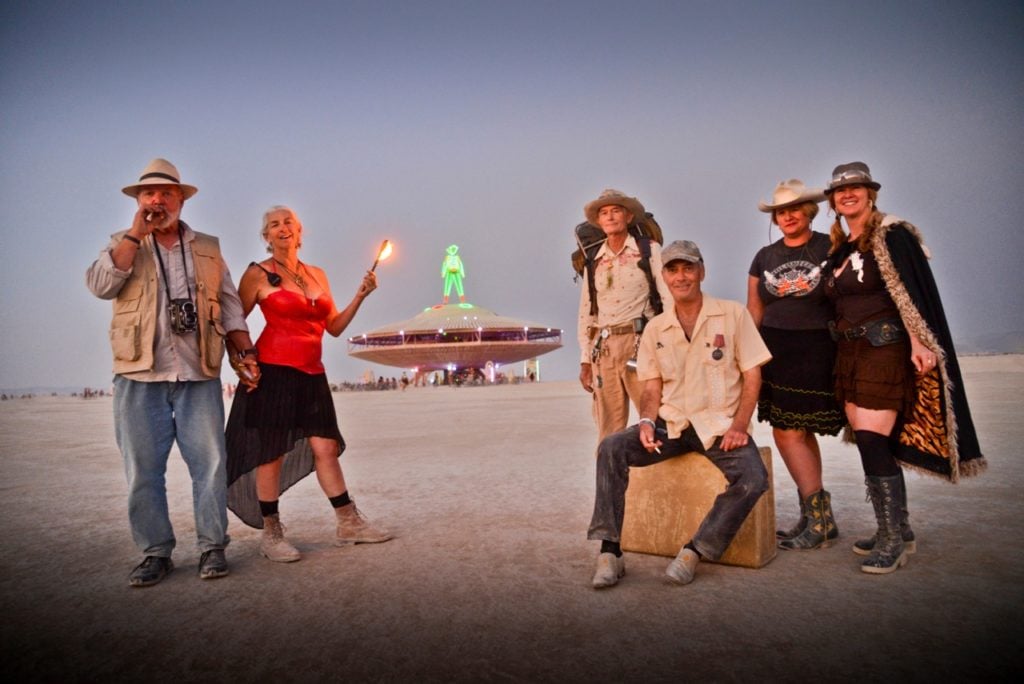
The curator of "City of Dust: The Evolution of Burning Man" at the Nevada Museum of Art talks to artnet News.

Sarah Cascone

Nothing compares to personally witnessing the week-or-so-long spectacle that is Burning Man, held in Nevada’s remote Black Rock Desert. For those who can’t make it, however, the Nevada Museum of Art is offering the next best thing: “City of Dust: The Evolution of Burning Man,” an exhibition dedicated to the history of the famed gathering.
“No museum has ever begun to unravel the story of Burning Man,” exhibition curator Ann M. Wolfe, who attended the last three editions of Burning Man ahead of the show, told artnet News. The museum is a natural venue for the exhibition, as it just two hours from the Black Rock Desert. It also acquired a 6,000-object Burning Man archive four years ago.
Following its run in Nevada, a portion of the exhibition will travel to the Renwick Gallery of the Smithsonian American Art Museum in Washington, DC, next year as part of “No Spectators: The Art of Burning Man.”
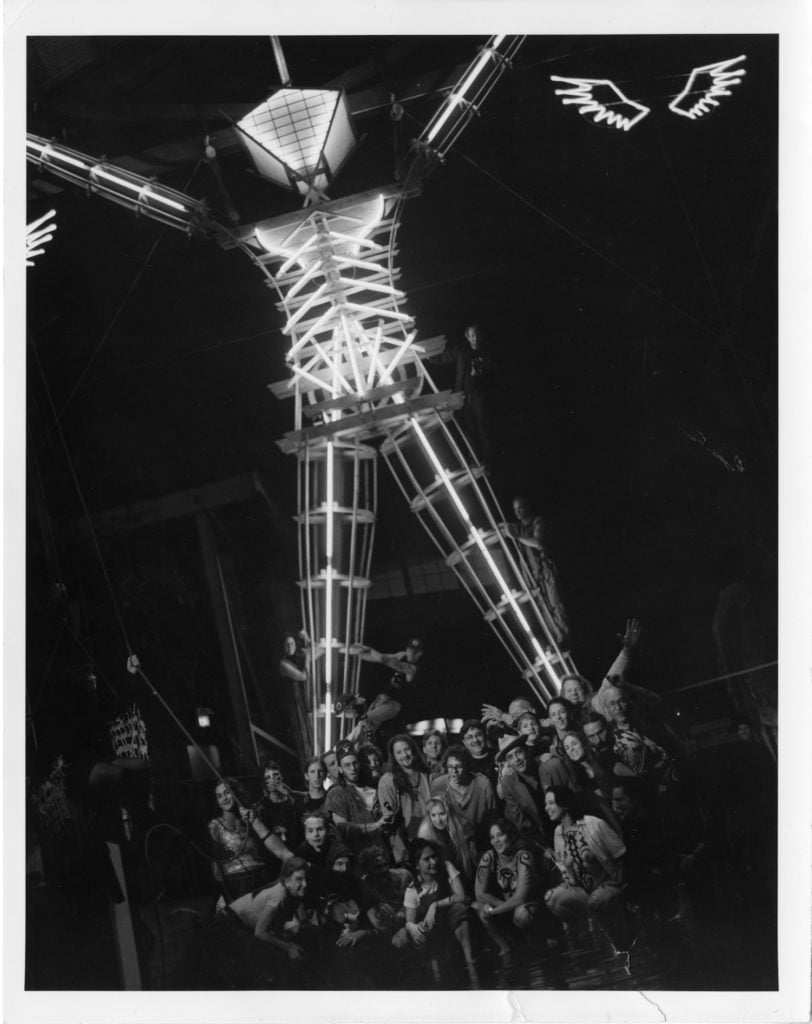
A. Leo Nash, photograph of Burning Man guests with the man statue. Courtesy of the Nevada Museum of Art.
While Burning Man may have the reputation of being a bacchanalian festival full of hippies, techies, and everyone in between, the museum is focusing on the gathering as a place, examining the origins of Black Rock City, the sprawling temporary town that springs up on the playa each year, housing 70,000 guests before melting away.
“It’s about looking at the gathering through an anthropological and archaeological lens, using primary documents to show how it came about,” said Wolfe. “Most of these objects have never been on view.”
A substantial portion of the show is dedicated, of course, to the art of Burning Man, famous for the massive, elaborate sculptures that rise above the desert plain each summer.
“There’s a beautiful arc about how art has evolved through this gathering that is Burning Man. But you have to broaden your definition of art,” Wolfe explained. “Everything about Burning Man is about cultural expression and creative expression—even the act of going to Burning Man.”
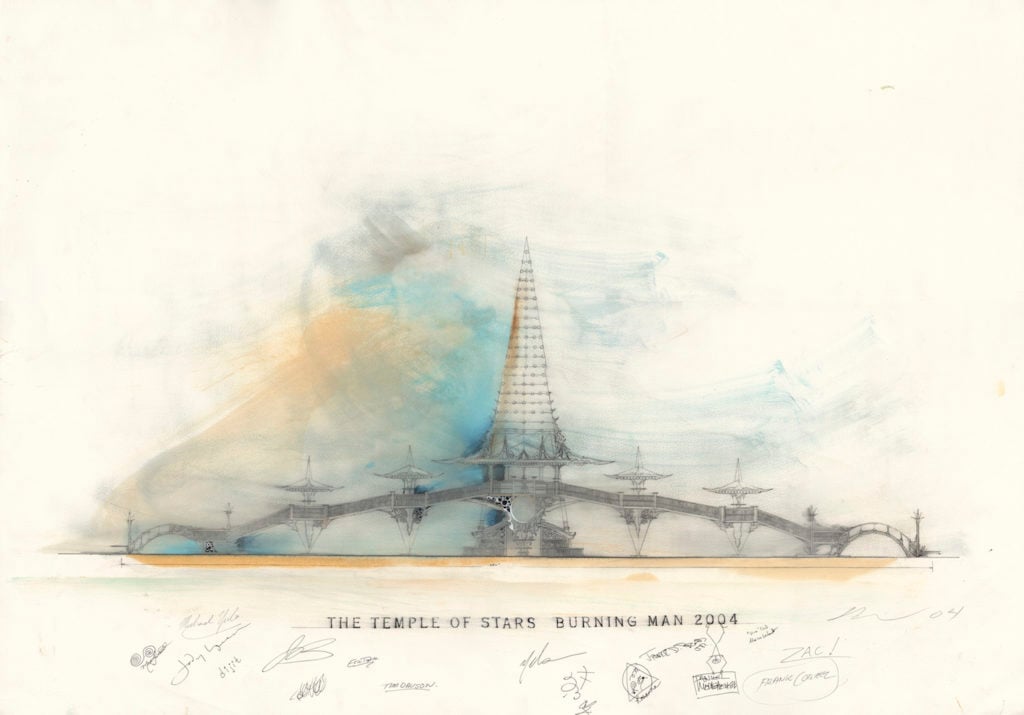
David Best, design for the 2004 temple at Burning Man. Courtesy of the Nevada Museum of Art.
That’s not to say there aren’t some well-known artists who have contributed over the years. David Best, who since 2000 has designed the elaborate Burning Man Temple nine times, is represented by some 20 drawings and sketches. (The Smithsonian’s show will feature a new Best temple commissioned for the museum rotunda.)
There are also materials related to the work of Argentinian artist Pepe Ozan, who staged ritualized performance art operas at Burning Man between 1996 and 2002, his sculpture serving as the set design.
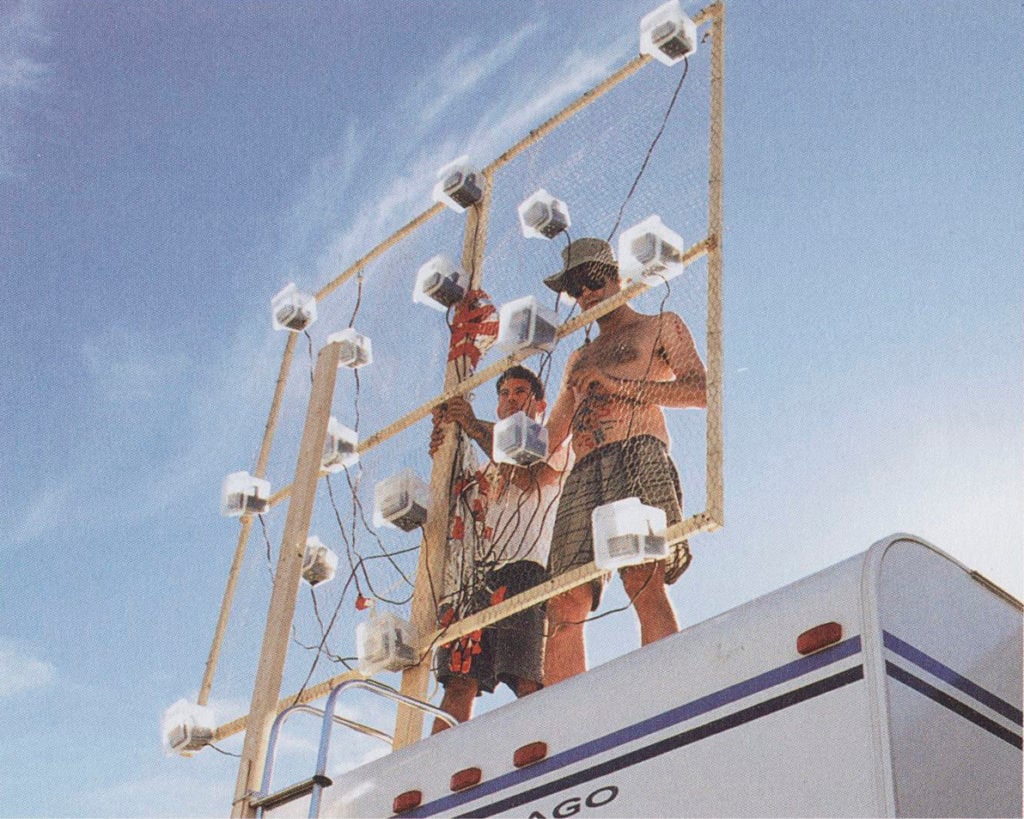
Artist Leo Villareal installs a light-based way-finding device atop Disorient Camp at Burning Man, where he first began making art (1997). Courtesy of the artist.
Leo Villareal, best known for The Bay Lights, an illuminated installation on the Bay Bridge between Oakland and San Francisco, is represented by two works in the show. The first is a light-up wayfarer sculpture that he hung above his camp. “In the desert, there’s a disorienting sense of scale,” said Wolfe, explaining its function.
A second is a series of tiny illuminated “blinkie” sculptures that he would hand out to Burning Man guests, in the spirit of generosity (one of the gathering’s “10 guiding principles”).
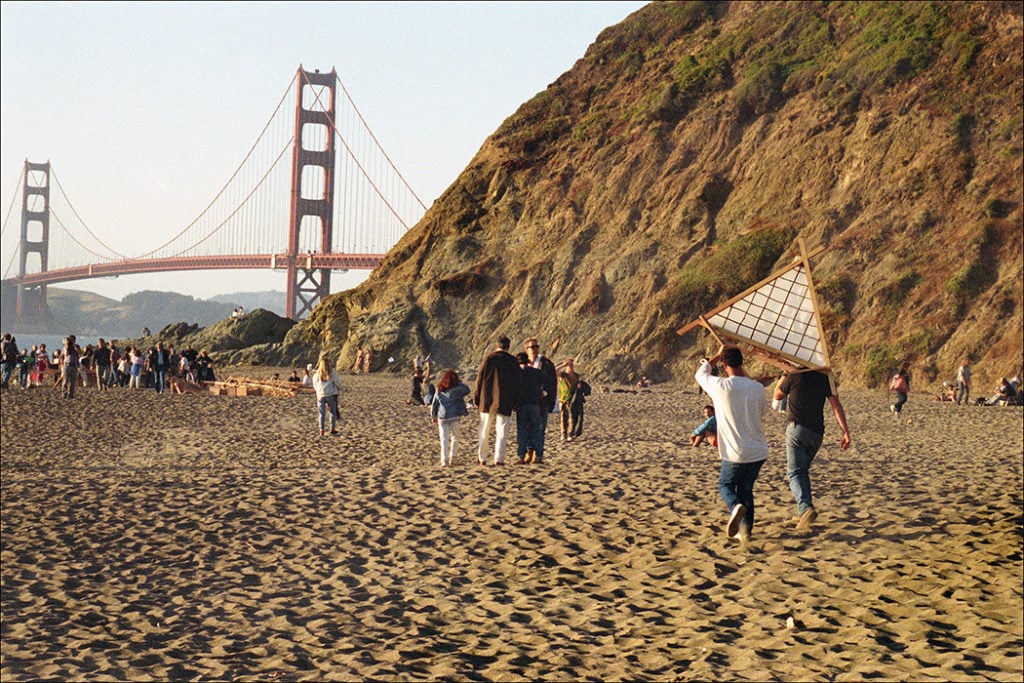
An early Burning Man on Baker Beach in San Francisco. Courtesy of the Nevada Museum of Art.
Founded by Larry Harvey and Jerry James in 1986, Burning Man was originally an informal Bay Area event, held on San Francisco’s Baker Beach and attracting just a dozen participants who, without permits or permission, set a wooden effigy of a man alight.
It was, said Wolfe, a “sculptural installation that really spawned an entire movement,” soon outgrowing the beach and moving to the desert in 1991.
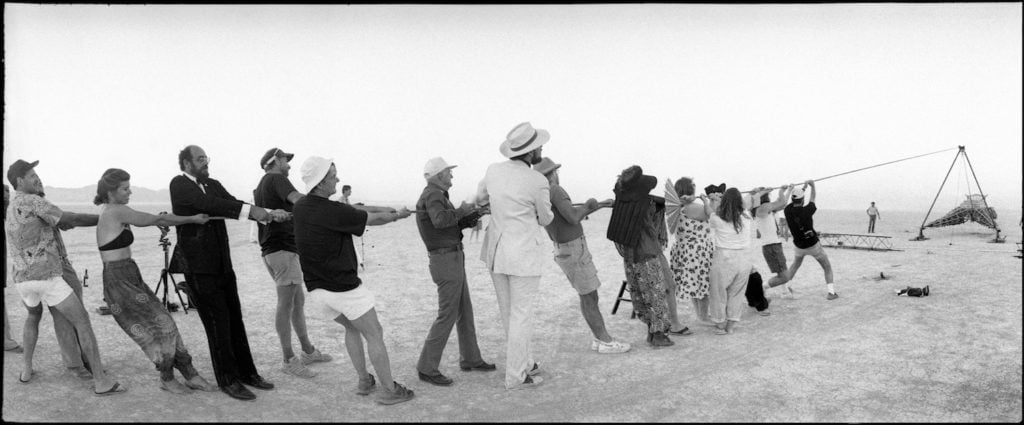
Stewart Harvey, the raising of the Burning Man in 1990, the first time the event took place in the Black Rock Desert. Courtesy of the Nevada Museum of Art.
There were some further growing pains in 1996, a pivotal year covered in the exhibition in a section titled “On the Edge of Anarchy.” With casual firearm use, high-speed driving, and heavy drug and alcohol use among the now-8,000 guests, safety concerns were growing. Following a fatality just prior to the gathering, Burning Man was not allowed to return to its usual site the following year. They needed to get serious about organizing an infrastructure for Black Rock City.
Urban planner Rod Garrett stepped in. “I’d had quite a lot of experience with planning and building departments and dealing with cities and counties,” he said in a 2010 New York Times interview. “They were in trouble, and I helped.”
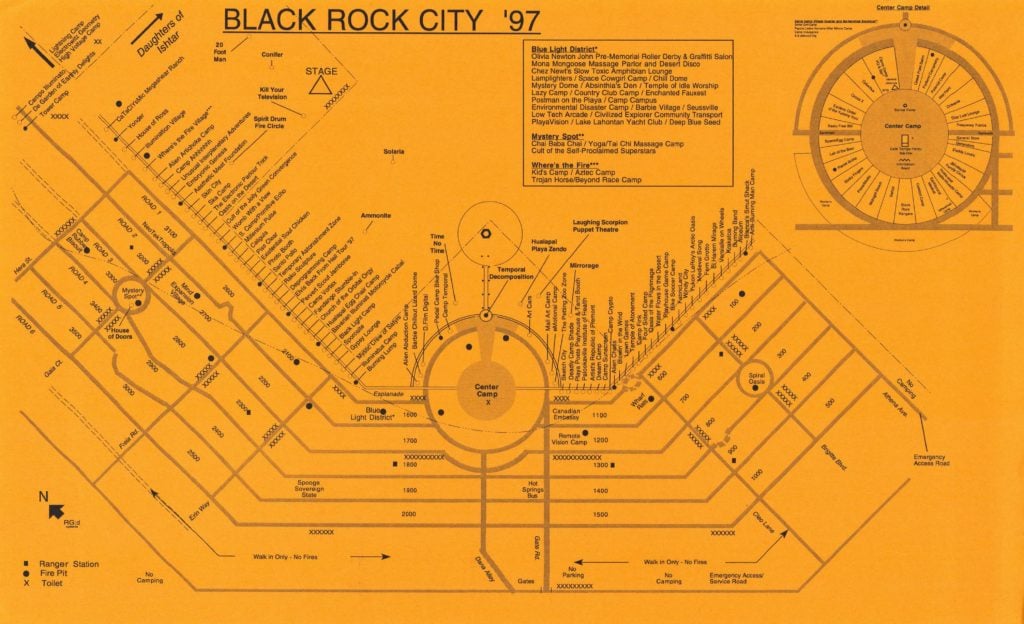
Design for Black Rock City held on a privately-owned section of Hualapai Flat. Design by Rod Garrett, with camp placement by Harley K. Dubois, and text design by Scout Addis (1997). Courtesy of Burning Man Project.
Garrett’s civic design laid out the gathering in a series of concentric semi-circles. The iconic Burning Man statue stands in the center, surrounded by the artworks, and then a series of neighborhoods, which visitors traverse via radial roads.
“It’s very different from how most cities are laid out in a gridded format, and it allows for greater participation and communication among citizens,” Wolfe explained. “Upon that semi-circular structure you have the fabric of the city develop. That’s where art and culture comes into play, and spirituality through the temples.”
Wolfe has incorporated some of the original documents related to Garrett’s design and the gathering’s civic growth, as well as paperwork from Burning Man’s recent transition from LLC to nonprofit.
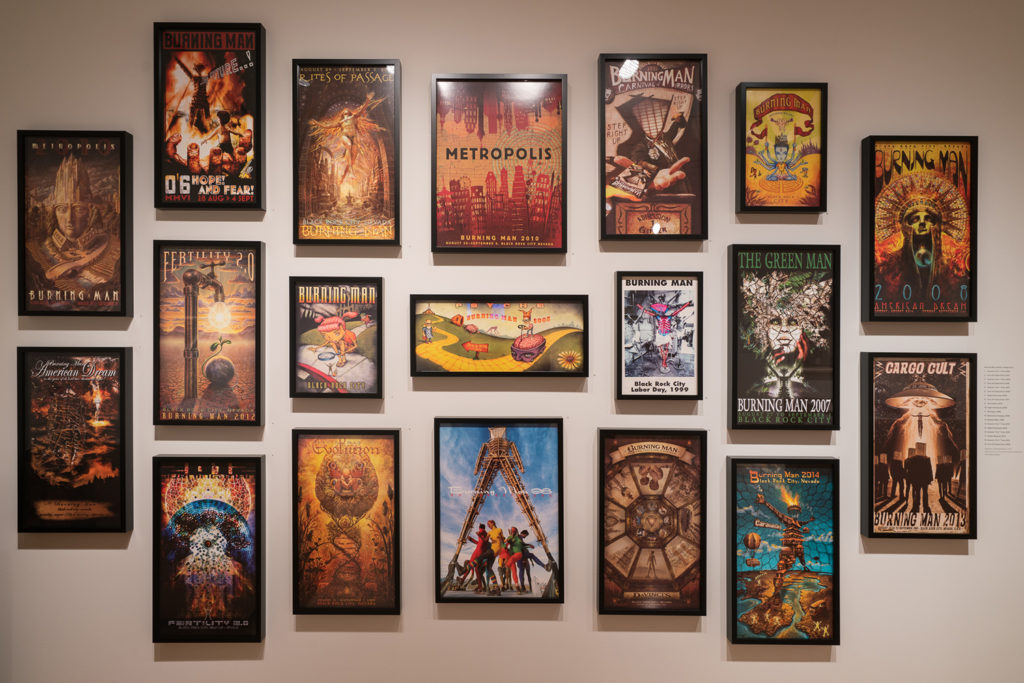
Installation view of “City of Dust: The Evolution of Burning Man” at the Nevada Museum of Art. Courtesy of Nevada Museum of Art.
The exhibition also looks at the proliferation of Burning Man art beyond the desert playa. “The Black Rock Arts Foundation was instrumental in starting to place artwork created for and at Burning Man in communities in the West and eventually throughout the nation and the world,” said Wolfe.
As Burning Man’s popularity has grown, the scale of the event necessarily shed some of its original countercultural ethos. “You kind of reach a tipping point in the early 2000s,” Wolfe admitted. “It’s hard to get access to Burning Man; ticket prices are very high.”
Given the cultural phenomena that is Burning Man today, its humble beginnings and explosive growth, demonstrated in the exhibition, are all the more impressive. “You’re able to look behind the scenes at how Burning Man developed,” said Wolfe, and “take an objective look at the many voices that have gone into its creation.”
“City of Dust: The Evolution of Burning Man” is on view at the Nevada Museum of Art, 160 West Liberty Street, Reno, Nevada, July 1, 2017–January 7, 2018.